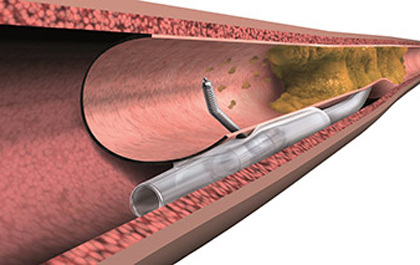Although chronic total occlusion (CTO) is a common finding, there is little consensus as to when such lesions should be treated routinely with angioplasty. Benefits of successful rechanneling include relief of symptoms, resolution of ischemia, improvement in ventricular function, and avoidance of myocardial revascularization surgery. Unsuccessful rechanneling is common and may be associated with several adverse events,…
Successful CTO reduces local and remote residual ischemia
Courtesy of Dr. Carlos Fava. The presence of Chronic Total Occlusion (CTO) is about 30%, with an ischemic threshold between 10% and 12.5% to justify rechannelization. Using the new devices, the new guidelines and with more experience operators, these procedures are successful in 10% to 30% of cases. More often than not these patients are not treated…
CTO in patients with acute myocardial infarction increases long term mortality
Courtesy of Dr. Carlos Fava. It has been proved that in a setting of acute myocardial infarction with multivessel lesions, only the culprit vessel must be treated (if there is no hemodynamic compromise) at first, and other severe lesions are to be treated during a second session. However, proper conduct in cases with presence of chronic…
Success in CTOs caused by restenosis lowers cardiac mortality
Courtesy of Dr. Carlos Fava. Nowadays, chronic total occlusions (CTO) due to in-stent restenosis (ISR) represent 5%-25% of all coronary angioplasties. These lesions pose a new and true challenge, since CTOs are often associated with stent-related problems (fractures, lack of expansion, overlapping, deformation), extreme tortuosity, severe calcification, tandem lesions after CTO, and aorto-ostial lesions, with little…
Are 7 Fr Dedicated Transradial Introducers Safe?
Courtesy of Dr. Carlos Fava. The transradial approach has been proven beneficial for quite some time now, but certain scenarios require the use of a 7 Fr or 8 Fr introducer, which is a great limitation. This study included 60 patients who underwent complex angioplasty with the help of 7 Fr dedicated transradial (TR) introducer Glidesheath Slender (Terumo, Tokyo,…
EuroCTO: Rechanneling vs. Optimal Medical Treatment in Total Occlusions
Courtesy of the SBHCI. Chronic total occlusions represent around 18% of all coronary lesions. However, they account for just 5% of all interventions, which means that many patients only receive medical treatment. This prospective, open, multicenter study randomized patients with multivessel lesions in whom at least one of these was a chronic total occlusion. Patients…
PRISON IV: DES with resorbable polymer vs. DES with permanent polymer in total occlusions
Courtesy of SBHCI. The PRISON IV trial compared the sirolimus eluting stent with ultra-thin struts and biodegradable polymer vs. the second-generation everolimus-eluting stent with thin struts and durable polymer in successfully recanalized chronic total occlusions. This is a sub-study with optical coherence tomography (OCT). The study included 330 patients, 85% angiographically followed up at…
Successful CTO: associated to higher survival rate?
Courtesy of Dr. Carlos Fava. The presence of chronic total occlusions (CTO) in coronary angiograms varies between 5% and 30%, depending of the different analyzis. Likewise, they have been associated to higher mortality rate and the need for myocardial revascularization surgery. The frequency of CTO PCI is low across the different series (3.8%), though…
In-stent CTO: different prognosis from that of De Novo CTO?
Courtesy of Dr. Carlos Fava. Chronic Total Occlusions (CTO) are truly challenging and different technologies are being developed to treat them, but currently our most pressing questions about them are whether in-stent CTO present the same success rate as de novo CTO, and what their prognosis is. The present trial analyzed 899 CTO: 111(12.3%)…
DECISION-CTO: Prevailing Questions on CTO Rechanneling
The first and only randomized trial on chronic total occlusion (CTO) revascularization versus optimal medical therapy in stable patients has disappointed interventional cardiologists. According to Dr. Seung-Jung Park, who presented the study, evidence suggests that optimal medical therapy is a reasonable initial treatment strategy for chronic total occlusion, when compared with angioplasty. Critics…









